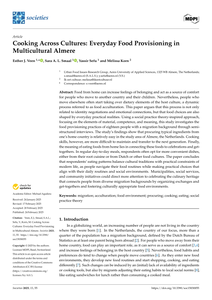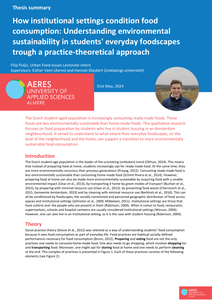Increasing attention has been paid to the ‘voice’ of people living with mild cognitive impairment (or dementia, but there is a lack of clarity about how everyday life is perceived from this insiderinsider’s perspective. This study aimed to explore the everyday life experiences, challenges and facilitators of individuals with MC I and dementia living at home.
DOCUMENT

This study aims to map VE teachers’ perceived importance of assessment competence. The study was conducted in the Netherlands among teachers of professional studies in Universities of Applied Sciences. A large-scale study was conducted to represent a broad population of teachers, including various vocational fields, roles, and situations, allowing for the exploration of differences across these contextual variables.
LINK
Increasing attention has been paid to the ‘voice’ of people living with mild cognitive impairment (MCI) or dementia, but there is a lack of clarity about how everyday life is perceived from this insider’s perspective. This study aimed to explore the everyday life experiences, challenges and facilitators of individuals with MCI and dementia living at home. A scoping review of qualitative studies, guided by the Joanna Briggs Institute Reviewers Manual, was conducted. Eight databases were searched, resulting in 6345 records, of which 58 papers published between 2011 and 2021 were included. Analysis was carried out by descriptive content analysis. Findings were categorized into seven spheres of everyday life: experiences related to the condition, self, relationships, activities, environment, health and social care and public opinions. The results show many disruptions and losses in everyday life and how people try to accommodate these changes. In all areas of everyday life, people show a deep desire to have reciprocal relationships, stay engaged through participation in activities and have a sense of belonging in the community. However, more research is needed on the factors that promote and impede the sense of reciprocity and belonging.
MULTIFILE

Food from home can increase feelings of belonging and act as a source of comfortfor people who move to another country and their children. Nevertheless, people whomove elsewhere often start taking over dietary elements of the host culture, a dynamicprocess referred to as food acculturation. This paper argues that this process is not only related to identity negotiations and emotional connections, but that food choices are also shaped by everyday practical realities. Using a social practice theory-inspired approach, focusing on the elements of material, competence, and meaning, this study investigates the food provisioning practices of eighteen people with a migration background through semistructured interviews.Keywords: migration; acculturation; food environment; procuring; cooking; eating; social practice theory
DOCUMENT

The Dutch student-aged population is increasingly consuming ready-made foods. These foods are less environmentally sustainable than home-made foods. This qualitative research focuses on food preparation by students who live in student housing in an Amsterdam neighbourhood. It aimed to understand to what extent their everyday foodscapes, on the level of the neighborhood and the home, can support a transition to more environmentally sustainable food consumption. This is a thesis summary.
DOCUMENT

Background: Although research on children's motor competence is a growing field of interest, especially among young children (4-6 years), several questions remain to be answered. Differences in children’s motor competence and their determinants, must be made transparent since early childhood is a critical period for the development of fundamental movement skills, and thereby a lifelong active lifestyle and health. Objective: The purpose of this cross-sectional study was to determine differences in actual motor competence (AMC), perceived motor competence (PMC) and enjoyment of physical activity among young children with different weight status. Methods: AMC, PMC and enjoyment were measured among 1708 children (50.4% male, mean age: 5.34 ± 0.73 years) from 36 primary schools in The Netherlands. AMC was measured by using the Athletic Skills Track (AST-1). The Pictorial Scale of Perceived Movement Skill Competence for Young Children was used for determining PMC and enjoyment of physical activity was measured using a Visual Analogue Scale. The data were analyzed using a three-way ANOVA to examine the differences between AMC, PMC and enjoyment by sex (boys/girls), age (4, 5, 6 years) and weight status (normal, overweight, obesity). Results: Overall, AMC was ranked as ‘average motor gifted’. Average PMC and enjoyment scores were 3.31 (SE 0.01) (1-4 scale) and 4.41 (SE 0.02) (1-5 scale) respectively. No interaction effects were found between sex, age and weight status on AMC or PMC. However, there was a statistically significant two-way interaction effect for enjoyment between age and weight status (F (4,1454) =2.464, p =.043). Relative enjoyment scores for normal weight and overweight groups between high and low enjoyment were distributed 99% to 1%. However, in the obese group there was a distribution of 92% to 8% between high and low enjoyment. Conclusions: The results of this study suggest that there are no significant differences in AMC and PMC between children of different sex, ages (4, 5 and 6 years), and weight status in this age group. However, children with obesity more often experience less enjoyment during physical activity than children with another weight status. Targeted intervention for increasing enjoyment during physical activity in combination with reducing obesity seems advisable even at young age.
DOCUMENT

Background: This study investigated the trajectories of decline in individual instrumental activities of daily living (IADL) with aging and the effect of hearing loss, vision loss, or dual sensory loss on these trajectories in community-living frail older persons. Method: This longitudinal population-based study was conducted in 9,319 community-living frail Dutch persons aged 60 years and older. Self-reported hearing loss, vision loss, or dual sensory loss and nine IADL were assessed in 15 studies of the Dutch National Care for the Elderly Program (The Older Persons and Informal Caregivers Survey Minimum Dataset). Probabilities of limitations in IADL, odds ratios (per 5 years) for binary, and rate ratios (per 5 years) for score outcomes were calculated using mixed logistic and negative binomial models with age as the underlying timescale, stratified by sensory loss, and corrected for confounders. Results: At baseline, the number of IADL limitations was higher in dual sensory loss (2.00 [interquartile range 1.00–4.00]) and vision loss (2.00 [interquartile range 1.00–4.00]) compared to no sensory loss (1.00 [interquartile range 0.00–2.00]) or hearing loss (1.00 [interquartile range 0.00–3.00]). Trajectories of individual IADL showed an increase in limitations in all IADL with age. Household tasks, traveling, shopping, preparing a meal, and walking showed the most rapid decline. Handling finances, traveling, and walking followed a different pattern of decline based on sensory loss status. Conclusions: The age effect on limitations in IADL appears to be similar across all types of sensory loss, with the exception of handling finances, traveling, and walking. At baseline, persons with self-reported sensory loss had higher levels of self-reported functional limitations. Trajectories depict a decline in IADL competence with age.
DOCUMENT
To make effective financial decisions, individuals need both financial and numerical competence. The latter includes having numerical knowledge and skills, and the ability to apply them in a financial context. A positive attitude towards numbers, combined with the absence of math anxiety, proves beneficial. Additionally, higher-order numerical skills enhance the quality of financial decision-making. Challenges in any of these numeracy aspects may contribute to financial difficulties. However, the specific aspects of numeracy that are of crucial importance remain unclear. Therefore, our research addresses the question: Which aspects of numeracy are related to having financial problems? In this article, we explore this question through a literature review.
DOCUMENT

The present study aims to investigate if – and if so, how – the intercultural training programme ‘Preparation for Foreign Learning Experience’ (PREFLEX) has a positive effect on the development of the intercultural competence of students at THUAS in international groups (i.e. school for International Business and Management Studies, IBMS) and students in intercultural groups (i.e. school for Commercial Economy, CE). In addition, the study aims to advance the design of the programme further. Accordingly, the study addresses the following central research question: In what way do the intercultural classroom and the international classroom contribute to the development of intercultural competences in first-year students at THUAS, and to what extent does preparation and guidance, by means of the PREFLEX training module, effectively enhance this development?
DOCUMENT

Improved cookstoves aimed at reducing exposure to indoor air pollution have had a lasting presence in development and health discussions. Through this article we contribute to current debates in the field by reflecting on our experiences during a cookstove participatory project in two ‘non-notified’ communities, or ‘slums,’ in Bangalore, India. We interrogate the alignment between some of the central tenets and methods of participation and the lived experiences of participating communities. The current predominant recommendations focus on developing and implementing cookstoves tailored for user needs. Yet, the project implementation entered a space of uncertainty where the priorities and needs of participants were diverse and changing. While urban infrastructures related to housing and work security, drainage systems, access to health care, and aspects of governance, citizenship and rights, may seem to fall outside the scope of ICS projects, our experiences show how inescapably they shape participatory processes and technologies. We highlight the need to take a closer look at how we can include these broader and changing priorities and needs in our methodologies and reflect on how we can better respond and align them with the ways in which people live.
MULTIFILE
